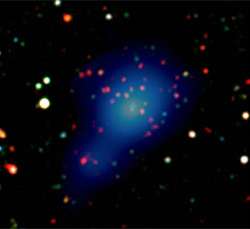
An international team of astronomers have used ESA’s XMM-Newton X-Ray observatory to image the most distant galaxy cluster ever seen. This cluster contains hundreds of galaxies, and is located nearly 10 billion light-years from Earth, so it’s seen when the Universe was less than 4 billion years old. Its existence challenges current theories about galaxy evolution – a structure this large shouldn’t exist so early in the Universe.
The most distant cluster of galaxies yet has been discovered by astronomers from the U.S., Europe and Chile. The finding was announced at the 208th American Astronomical Society meeting in Calgary, June 5.
Almost 10 billion light-years from Earth, cluster XMM-XCS 2215-1734 contains hundreds of galaxies surrounded by hot X-ray-emitting gas.
The existence of the cluster so early in the history of the universe challenges ideas about how galaxies formed, said lead author Adam Stanford, a research scientist at UC Davis and the Lawrence Livermore National Laboratory.
“It’s like finding a picture of your grandfather as an adult in the nineteenth century — how could he have existed so long ago?” Stanford said.
Using the temperature of the X-ray emitting gas, Kivanc Sabirli, a graduate student at Carnegie Mellon University, determined that the cluster is approximately 500 trillion times the mass of our sun. Most of the mass is “dark matter,” a mysterious, invisible form of matter that dominates the mass of all galaxies in the universe.
The XMM Cluster Survey (XCS) team used observations from the European X-ray Multi Mirror (XMM) Newton satellite to discover the cluster and then determined its distance from Earth using the 10-meter W.M. Keck telescope in Hawaii. The team is working on a long-term observing program to find hundreds more such clusters using telescopes around the world.
In addition to Stanford and Sabirli, the research team includes: Kathy Romer, University of Sussex, U.K.; Michael Davidson and Robert G. Mann, University of Edinburgh and the Royal Observatory Edinburgh, U.K.; Matt Hilton and Christopher A. Collins, Liverpool John Moores University, U.K.; Pedro T.P. Viana, Universidade do Porto, Portugal; Scott T. Kay, Oxford University, U.K.; Andrew R. Liddle, University of Sussex, U.K.; Christopher J. Miller, National Optical Astronomy Observatory, Tucson; Robert C. Nichol, University of Portsmouth, U.K.; Michael J. West, University of Hawaii and the Gemini Observatory, Chile; Christopher J. Conselice, University of Nottingham, U.K.; Hyron Spinrad, UC Berkeley; Daniel Stern, Jet Propulsion Laboratory; and Kevin Bundy, California Institute of Technology. The work was funded by NASA, the Particle Physics and Astronomy Research Council (U.K.), the Hosie Bequest, and the National Science Foundation.
Original Source: UC Davis News Release
